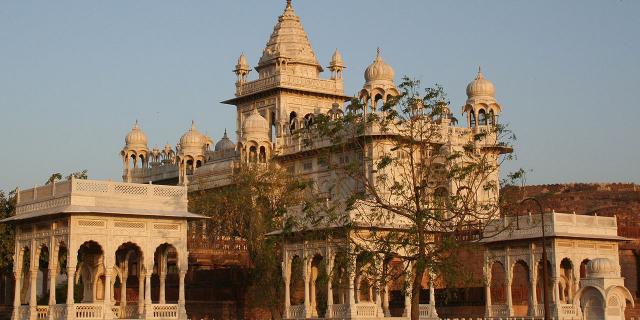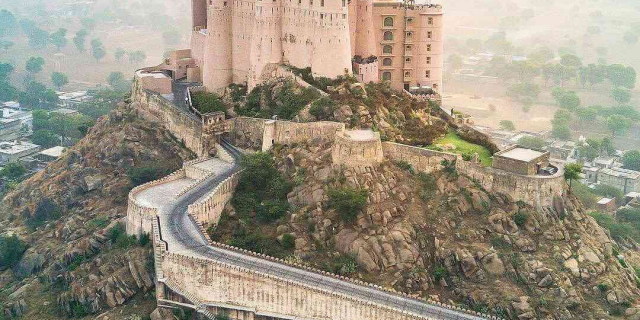Pushkar Lake or Pushkar Sarovar is located in the town of Pushkar near Ajmer city in Ajmer district of the Rajasthan state of western India. Pushkar Lake is a sacred lake of the Hindus. The Hindu scriptures describe it as "Tirtha-Guru" [Thirtha Raj]– the perceptor of pilgrimage sites related to a water-body and relate it to the mythology of the creator-god Brahma, whose most prominent temple stands in Pushkar. The Pushkar Lake finds mention on coins as early as the 4th century BC.
Pushkar Lake is surrounded by 52 bathing ghats (a series of steps leading to the lake), where pilgrims throng in large numbers to take a sacred bath, especially around Kartik Poornima (October–November) when the Pushkar Fair is held. A dip in the sacred lake is believed to cleanse sins and cure skin diseases. Over 500 Hindu temples are situated around the lake precincts.
Tourism and deforestation in the surroundings have taken a heavy toll on the ...Read more
Pushkar Lake or Pushkar Sarovar is located in the town of Pushkar near Ajmer city in Ajmer district of the Rajasthan state of western India. Pushkar Lake is a sacred lake of the Hindus. The Hindu scriptures describe it as "Tirtha-Guru" [Thirtha Raj]– the perceptor of pilgrimage sites related to a water-body and relate it to the mythology of the creator-god Brahma, whose most prominent temple stands in Pushkar. The Pushkar Lake finds mention on coins as early as the 4th century BC.
Pushkar Lake is surrounded by 52 bathing ghats (a series of steps leading to the lake), where pilgrims throng in large numbers to take a sacred bath, especially around Kartik Poornima (October–November) when the Pushkar Fair is held. A dip in the sacred lake is believed to cleanse sins and cure skin diseases. Over 500 Hindu temples are situated around the lake precincts.
Tourism and deforestation in the surroundings have taken a heavy toll on the lake, adversely affecting its water quality, reducing the water levels and destroying the fish population. As part of conservation measures, the government is undertaking de-silting, de-weeding, water treatment, and afforestation as well as mass awareness programme.
 An artist's view of Pushkar Lake in late 18th century during British rule
An artist's view of Pushkar Lake in late 18th century during British rulePushkar Lake's history dates back to the 4th century BC. Numismatics, in the form of punched Greek and Kushan coins date the lake back to this time. The inscriptions found at Sanchi attest to the lake's existence to the 2nd Century BC. This suggests that Pushkar was a pilgrimage centre even if it did not lie on the trade route.[1]
In the fifth century AD, Chinese traveller Fa Xian made reference to the number of visitors to Pushkar Lake.[2]
A story tells of a ninth-century Gurjara king, Nahar Rao Pratihar of Mandore, chasing a white boar to the lakeshore on a hunting expedition. In order to quench his thirst, he dipped his hand into the lake and was astonished to see that the Leukoderma marks on his hand had disappeared. Impressed with the sacred curative nature of the lake, he got the lake restored to its glory. After discovering the curative characteristics of the lake water, people have since visited the lake to take a holy dip and cure themselves of skin problems.[3][4]
The creation of Pushkar Lake, as an artificial lake, is also credited to the 12th century when a dam was built across the headwaters of the Luni River. The 10th Sikh guru, Guru Govind Singh (1666–1708), is said to have recited the Sikh sacred text Guru Granth Sahib on the banks of the lake.[5]
During the Mughal rule, there was a short break in the lake's importance due to the levy of a pilgrim tax and a ban on religious processions. In 1615–16, the Mughal emperor Jahangir (1569–1627) built his hunting lodge (seen now in total ruins) on the shores of the Pushkar Lake to celebrate his victory over the local Rajput Rana (king). He came to this lodge 16 times for hunting during his stay in Ajmer, about 23 kilometres (14 mi) from Pushkar. This act violated the local tradition of not killing any animals in the precincts of the sacred lake. He also committed an idolatrous act by breaking the image of Varaha – the boar Avatar of the god Vishnu, as it resembled a pig and symbolically hurt Islamic sensitivity. Thereafter, Jahangir's grandson emperor Aurangzeb (1618–1707) destroyed and desecrated several temples, which were later rebuilt.[2][6] However, during the rule of Jahangir's father, Emperor Akbar (1542–1605), there was a revival of not only the lake but also the Ajmer's Dargah dedicated to sufi saint Moinuddin Chishti, of whom Akbar was a devout follower.[1]
The Rajput rulers of Amber, Bundi, Bikaner and Jaisalmer made great efforts to restore the importance of the lake and its surrounding temples. Credits given for modern additions to the building of ghats and the renovation/construction of temples go to Maharaja Man Singh I of Amber for the Raj Ghat and Man temple; Maha Rana Pratap for the Varaha temple; Daulat Rao Scindia for Kot Tirth Ghat, the Marathas-Anaji Scindia to the Koteshwar Mahadev temple and Govind Rao, the Maratha governor of Ajmer for Shiva Ghat; to the British rule for combining the religious pilgrimage with a cattle fair to generate taxes for improving the lake and its surroundings; and gifting of the Jaipur Ghat and the Main Palace on the ghat in 1956 by the Maharaja of Jaipur.[7]






























Add new comment